This gem from our archives originally appeared in the May 1993 issue.
Grade three students should have mastered the basics of counting rhythms using whole through eighth notes in any combinations, understanding and using the concepts of subdivision. They should understand what intonation is, what inherent intonation problems their instruments have, and such elementary solutions as alternate fingerings, slight embouchure adjustments, and slide adjustments. Students should have developed a characteristic tone by this level, applying the basic factors that aid in tone production: good posture, breathing habits, and embouchure flexibility.
When students can do each of these things adequately, they are ready for grade three music and the challenges of group intonation. Chorales and ballads are excellent for this because they entail long notes and slow tempos that give students time to hear and correct intonation problems. These pieces also teach students to play long phrases with proper breath support. Directors should emphasize phrase endings, balance, harmonic phrasing, and blend. Deir In De by Warren Barker (Barnhouse) is excellent for this purpose because of its long phrases.
Deir In De
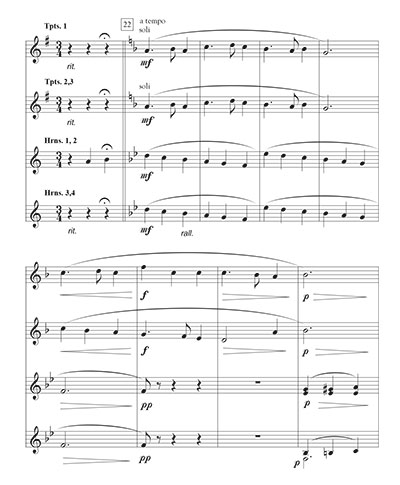
A piece I wrote, In Praise of Autumn (Barnhouse), has challenges in harmonic phrasing, breath control, and tone quality. The opening chord progression moves to measure seven before it is resolved, and this harmonic phrase should be treated as though it were a melodic phrase. Emphasize breathing and tone control.
In Praise of Autumn
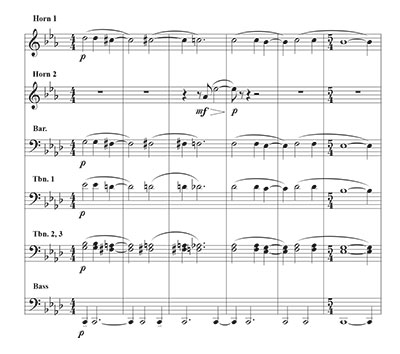
The limited sales of ballad-style works probably reflects that directors shy away from slow pieces because they accentuate deficiencies in the ensemble. Choose a piece that is a grade level below the ensemble’s ability to use as a warm-up exercise. Rather than playing the entire piece at every rehearsal, select a small portion for concentrated work on breathing or balance. When the band can do this well, move on to a more difficult composition. Gradually both the director and ensemble will gain confidence with slow works. Although ballads and chorales were not written as technical exercises, they work well for developing tone quality, blend, and balance. In adjudicating grade three bands, I have found that these are the areas in which most ensembles have difficulties.
Woodwind sections, particularly flutes, clarinets, and saxophones, usually have the most difficulty with intonation, blend, and balance. Flutes and clarinets usually play sharp in the upper register, and saxophones tend to overplay the woodwind sections, causing intonation and balance problems. Woodwind sections cannot blend if they are out of tune, directly affecting the entire ensemble’s intonation, balance, and blend. Select literature that features, the woodwind or brass sections separately so students can work in smaller groups and listen for pitch, textures, and blend. Works that have several musical ideas going simultaneously cause students to lose sight of the basics of good sound and blending. The opening of Somerset by Gary White (Boosey and Hawkes) focuses on sectional balance, blend, and intonation, and by practicing the thinly scored passages in sectionals students will play better in band.
Somerset
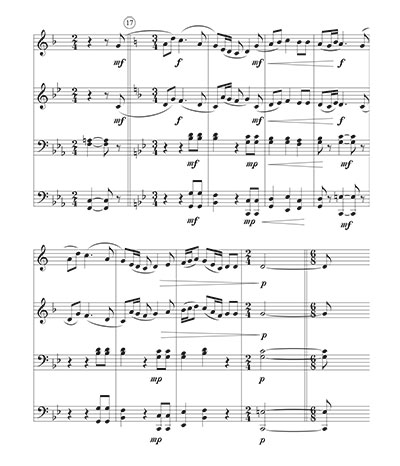
Becoming acquainted with a variety of musical styles is also important during this stage of development. Students and directors gain a greater vocabulary of articulations, tempos, dynamics, phrasing, and other musical elements by performing different types of music. Furthermore, programs of diverse repertoire appeal to larger groups of people, stimulating better attendance at concerts. Examples of the many styles available include American and British marches, ballads, classical transcriptions, compositions with mixed styles such as a chorale and dance, overtures, suites, folksongs, and programmatic works.
Three Folk Miniatures by Andre Jutras (C.L. Barnhouse) is a Canadian folksong that exhibits different settings while teaching phrasing, style, and multiculturalism. Praises by Francis McBeth (Southern Music) is an aggressive contemporary work that introduces students to twentieth-century harmonies, dynamic contrasts, and articulations. My Firecreek Legacy (Carl Fischer) is a programmatic work using melodic themes to denote specific characters; thus, the programmatic ideas create descriptive mental images that help students learn and perform a piece. New World Symphony by Dvo˘rák (arranged by James Curnow, published by Hal Leonard) is an orchestral arrangement ideally adapted for band. Curnow kept the original work’s romantic style, making the piece appropriate for teaching the interpretation of romantic tempos, accelerandos, ritards, phrasing, and articulations.
Level three ensembles should be proficient at articulating the following notations correctly:

Assigning each articulation a syllable and teaching everyone the same syllables improves precision and cleanliness within a group. There are many different syllables to select from, and directors have to experiment to find those that work best and then be consistent in teaching them. Variation Overture by Clifton Williams (Ludwig) and Toccata for Band by Frank Erickson (Bourne) focus on articulation; by selecting works such as these students learn how articulation relates to style.
Toccata for Band
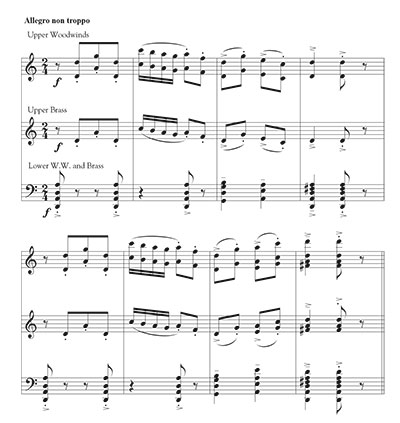
Being able to play fortissimo and pianissimo with good tone allows a band to perform more expressively. Brass and woodwind players tend to overplay fortissimos with a bright, harsh tone quality and underplay pianissimos with weak breath support and an airy tone. The primary cause of these problems is lack of breath support. By practicing crescendos, diminuendos, and sforzandos with precise articulation and characteristic tone quality, students can learn to control their breath support. Directors can vary scale exercises to accomplish this: begin each note of the scale at pp, gradually crescendo to ff, and then decrescendo to pp; begin each pitch ff, gradually decrescendo to pp, and then crescendo to ff; lastly, begin each pitch with a fp, making a gradual crescendo to f or ff.
Upon Wings of the Wind by Jared Spears (Counterpoint Music) illustrates the role of dynamics in expressing the composer’s intent. The sforzandos, crescendos, and decrescendos express the emotional and musical intent of the melodic line; without these nuances, the melody loses its spirit.
Upon Wings of the Wind
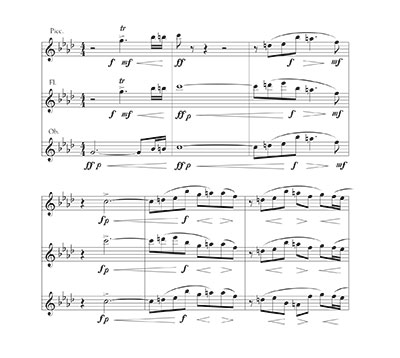
Directors should also use drills to expand students’ range in the extreme low and high registers because grade three repertoire includes more pitches. Scales, arpeggios, and lip flexibility exercises are good materials for drilling these new notes.
Solos can build confidence, pride, and self-esteem in students, but avoid works that feature instruments and players the ensemble lacks in good supply or quality. If you have limited horns, avoid pieces with four separate horn parts because these parts often add flavor to a composition. When ensembles have to omit parts, the composition suffers. Directors who select a work with four parts and have a small horn section could rescore the remaining parts for alto sax. If your ensemble lacks an oboe, bassoon, alto clarinet, or bass clarinet, double these parts in another instrument. It is also wise to check all third parts for technical demands because third players are usually the least experienced and can destroy an ensemble’s precision.
Percussion parts should add a measure of spice to a composition. Students lose interest if the parts are boring, and this can cause problems for a director. Choose pieces that include many parts that interact with the ensemble and evoke special effects and textural colors. Students at this level should be able to play all non-pitched percussion, xylophone, bells, chimes, and timpani. Jared Spears composed the percussion parts in Fallen, Fallen Is Babylon (Wingert Jones) to interact with the melodic, rhythmic, and harmonic structure of the piece; he gives percussionists an active role in the overall structure of the work.
Directors should perform compositions that encourage students to develop listening and interpretive skills. It is not enough to play notes; students should be aware of what the rest of the ensemble is playing. Grade three students should understand how the part fits into the ensemble as melody, countermelody, harmony, or rhythm; how to adjust for proper balance, blend, and intonation; proper fingerings and articulation techniques; and how to play with emotion and intellect instead of just making noise.
Poem for Band, Tatgenhorst; Counterpoint.
Hymn for Band, Stuart; Shawnee.
Air for Winds, Edmondson; Southern.
On a Hymn Tune for Philip Bliss, Holsinger; TRN.
Deir In De, Barker; Barnhouse.
In Praise of Autumn, Hilliard; Barnhouse.
Technique/Precision
Upon the Wings of the Wind, Spears; Counterpoint.
Overture for Winds, Carter; Bourne.
Exultate Jubilate, Mozart/C. Barnes; Ludwig.
Variation Overture, C. Williams; Ludwig.
Flourish for Wind Band, R. Williams; Ludwig.
Varying Styles and Forms
Firecreek Legacy, Hilliard; Fischer.
Princeton Variations, Shaffer; Barnhouse.
A Copland Portrait, Grundman; Boosey & Hawkes.
Psalm and Celebration, Elledge/Pearson; Kjos.
March on the Kings Highway, La Plante; Daehn.
El Relicario, Padilla/Longfield; Barnhouse.
Dance of Fire, Hilliard; Counterpoint.






